Last Modified 01 March 2024 |
First Added 09 July 2020
Understanding the Difference Between Feather and Down
When it comes to creating the perfect sleep sanctuary, every element matters, from the thread count of your sheets to the quality of your mattress, and the plushness of your duvet and pillows. In your search for the softest and most luxurious bedding, you may have encountered the terms "feather" and "down" in duvet and pillow fillings, leaving you curious about the difference between the two.
Feathers and down originate from the same source, namely ducks and geese, however their location on the bird’s plumage influences their distinct characters. While both can offer a beautifully soft and incredibly comfortable experience, understanding their nuanced differences is key in selecting the ideal luxury bedding for your own oasis. Let’s unravel the mysteries of feather and down to guide you on the way to your most restful night’s sleep.
What is feather?
The most common natural filling for duvets and pillows is feather or down, sourced from the plumage of ducks or geese to create an exceptionally luxurious level of comfort. Feathers come from the outer layer of the bird, typically from the wings and back, as opposed to down, which is from the deeper layers on the belly and chest. Feathers are larger with sturdy quills and branching vanes, essential for flight and protection, and provide a firmer, more supportive embrace in bedding.
Feather-filled duvets and pillows are ideal for those preferring structure and firmness, with a slightly heavier weight for warm, cosy nights, coupled with breathability to prevent overheating. They provide a satisfying fluffiness that maintains its shape over time, ensuring consistent support night after night. Feathers are more readily available than down, and therefore represent excellent value-for-money without compromising on quality.
Feather & Black’s luxurious Duck Feather Pillow is generously filled with ethically sourced natural duck feathers and encased in silky smooth 100% cotton percale, providing exceptional support and comfort. Pair your plush pillow with our White Snow Duck Feather Duvet, opulently filled with a rich blend of down and feather and wrapped in 330-thread count cotton for a soft, warm and wonderfully cocooning feel.
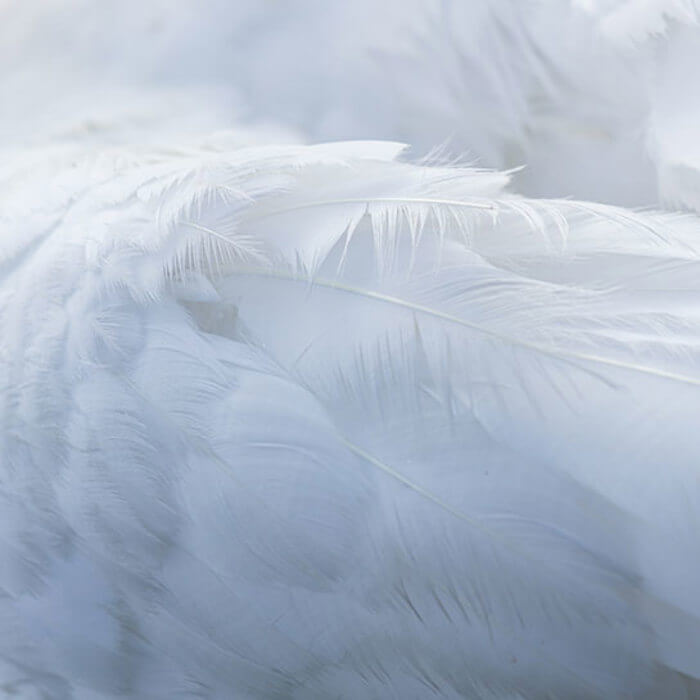
What is down?
Down is the incredibly light and fluffy undercoating found beneath the tougher, exterior feathers of ducks and geese, usually sourced from the belly or chest. Down clusters have a round centre known as plumule from which thousands of tiny fibres radiate – a little like the head of a dandelion. The round shape traps air allowing for exceptional warmth and weightlessness. Down duvets boast superior insulation, making them ideal for chilly climes and those who prefer lighter-than-air covers.
Down is renowned for its cloud-like comfort, like sinking into the softest marshmallow; its clusters conforming to the body to offer gentle support without feeling heavy. Its unparalleled properties make it by far the most prized duvet and pillow filling, considered the embodiment of luxury in bedding materials. Due to its rarity and delicate nature, down commands a higher price tag, however, its supreme quality and longevity ensure that it’s a worthwhile investment.
Feather & Black’s Hungarian Goose Down Duvet and coordinating Hungarian Goose Down Pillow epitomise indulgent luxury, filled with sumptuously soft goose down for unparalleled comfort and support all year round. The opulent filling ensures unmatched breathability and warmth, while the 330-thread count, pure cotton covers with piped satin edges offer added durability and softness for a truly lavish sleeping experience.
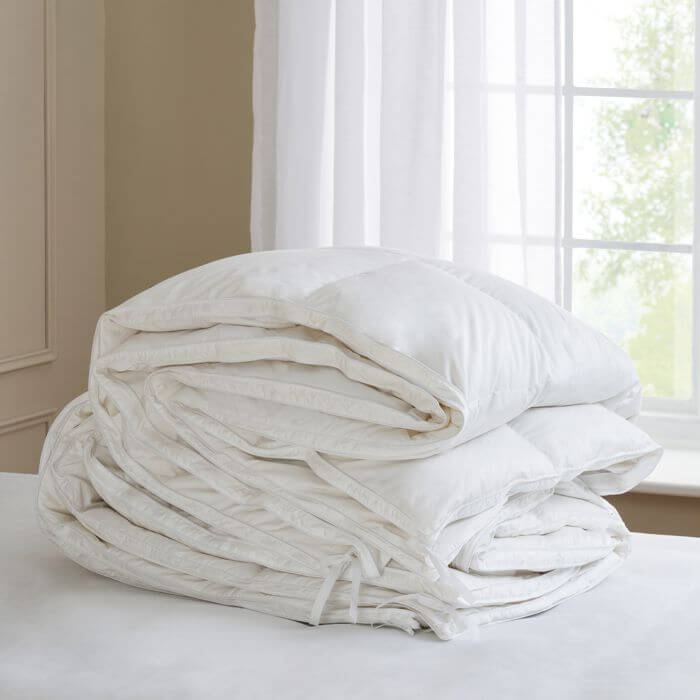
What is loft?
In the world of bedding, the term "loft" refers to the fluffiness or thickness of a duvet or pillow. It's what gives bedding its voluminous, cloud-like appearance and determines how effectively it retains warmth. The loft is achieved through the filling material – whether it's feathers, down or synthetic fibres – and its ability to trap air. High loft bedding creates a lofty, pillowy feel, while low loft bedding offers a flatter, more compact appearance.
When selecting bedding, consider the desired level of loft based on personal preference and sleeping habits. Those who prefer a plush, enveloping feel may opt for high loft options, while others may prefer the streamlined look and feel of low loft bedding. Understanding loft is fundamental in creating a sleep environment tailored to individual comfort needs, ensuring restful nights and rejuvenating mornings.
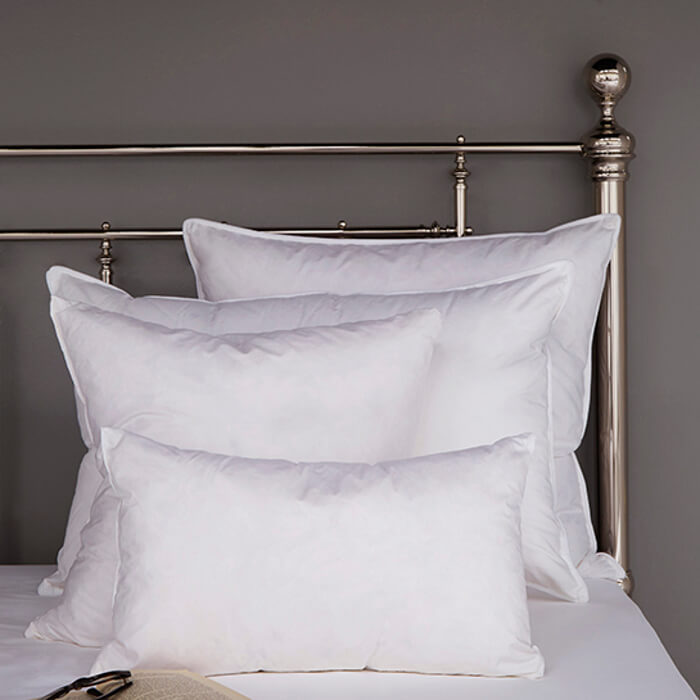
The benefits of feather and down
“Feather and down-filled bedding offers a myriad of benefits that contribute to a luxurious and restful sleep experience,” explains Feather & Black’s lead buyer Laura Burnett. “Both materials are prized for their natural insulating properties, providing warmth without excess weight, making them perfect for creating a cosy sleep sanctuary in any season. Additionally, feather and down clusters are highly breathable, allowing air to circulate and moisture to dissipate, which helps regulate body temperature and prevent overheating during sleep.
“Their resilience ensures lasting comfort and support, with feather-filled options offering firmness and structure, while down-filled bedding provides unparalleled softness and loft. Feather and down are also hypoallergenic options for many sleepers, as they are naturally resistant to dust mites and other allergens. By choosing our feather or down-filled bedding, you can indulge in the ultimate combination of luxury, comfort and quality craftsmanship for a truly blissful night's sleep.”
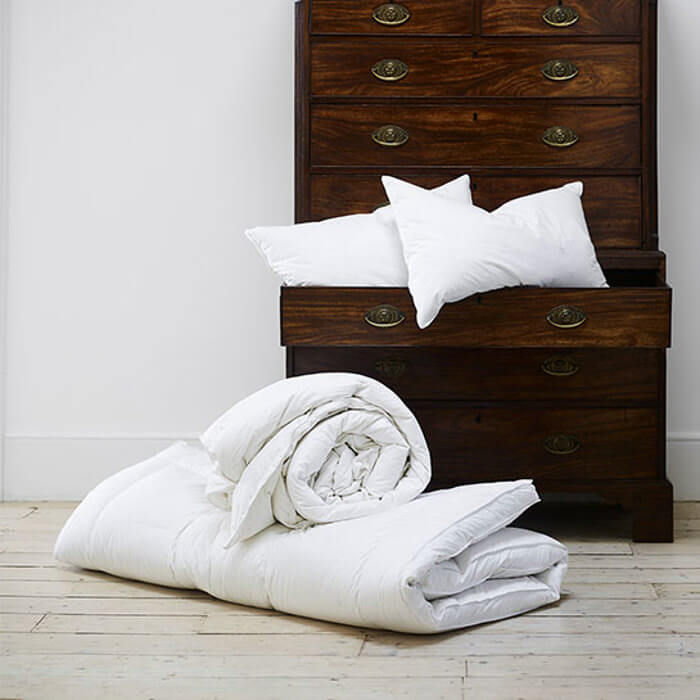
The difference between goose and duck
When selecting feather and down-filled bedding, another important factor to consider is the source of the filling. Both duck and goose offer exceptional quality and comfort, but there are subtle differences worth noting. Duck feathers and down are typically more abundant and affordable, making them a popular choice for those seeking luxury on a budget. Duck down clusters are smaller and may have a slightly less lofty feel compared to goose down, but they still provide excellent insulation and softness.
Goose feathers and down are renowned for their larger, fluffier clusters, resulting in a more luxurious and indulgent sleeping experience. As geese tend to live in colder climates, goose feather or down is extremely insulating and therefore often more expensive, however, many consider it worth the investment for its superior loft, warmth and durability. Ultimately, whether opting for duck or goose-filled bedding depends on personal preference, budget considerations and your desired level of luxury.

Caring for feather and down
To keep your feather or down duvet and pillows at their plushest, most luxurious best, treat them with regular care and attention to maintain their loft, softness and longevity. Fluff your bedding daily with gentle shaking to redistribute the filling and restore their lush appearance. Air your duvet and pillows occasionally by hanging them outdoors or in a well-ventilated room to remove moisture and odours, keeping your bedding fresh and inviting.
For minor spills and stains, your bedding can be spot cleaned with a mild detergent and warm water, however we recommend washing your duvet and pillows every two to three months for optimum freshness. Feather & Black’s feather and down duvets and pillows are machine washable at 40°C, making them incredibly easy to care for. With proper maintenance, your bedding will continue to provide the ultimate in comfort and quality for many years to come.
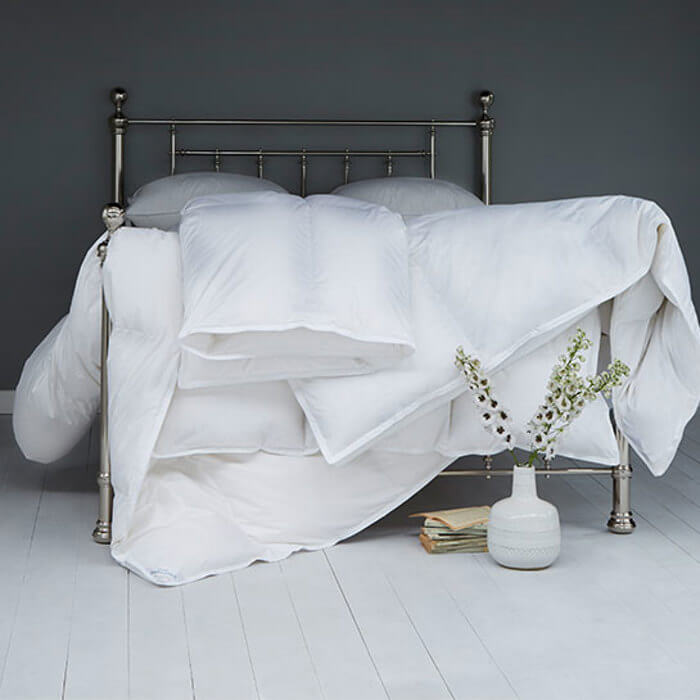
Feather vs down: a detailed comparison
Luxury bedding is an investment, and if you select your feather or down duvets and pillows with an informed approach, they should last for many years. It's recommended that pillows be replaced every one to two years, while duvets should be replaced every five to ten years, considering factors such as usage and wear. Signs that it may be time for a new duvet or pillow include flattened or clumped filling, loss of warmth or an overall decrease in comfort.
By refreshing your bedding regularly, you can continue to enjoy the luxurious warmth and cosiness it provides, ensuring your bed stays fresh and your sleep sanctuary remains a haven of comfort. When the time comes to replace your bedding, explore Feather & Black’s range of luxury feather and down-filled duvets and pillows. With our commitment to quality and craftsmanship, you can trust that you'll find bedding that offers unparalleled comfort and support, elevating your sleep experience to new heights of luxury and relaxation.
|
Feather fillings |
Down fillings |
|
Feathers are sourced from the outer layer of the bird, usually from the wings and back. |
Down is the fluffy undercoating sourced from the belly or chest. |
|
Feathers are heavier and flatter with sturdy quills. |
Down is lighter and airier, made up of fluffy clusters. |
|
Feathers provide firmness and structure, ideal for those who require ample support and a weightier feel while sleeping. |
Down's incredibly soft texture provides a luxurious sleeping experience, enveloping the body in gentle comfort. |
|
The sturdy composition of feathers ensures longevity and durability for long-lasting support. |
Down's superior thermal properties make it ideal for maintaining a comfortable sleep temperature in any season. |
|
Feathers, though warm, require a higher fill power to achieve the same level of insulation, resulting in a heavier, bulkier feel. |
Despite its insulating prowess, down is remarkably lightweight, allowing for a lofty feel without added bulk. |
|
Feathers offer a budget-friendly option without compromising on quality. |
The exceptional quality of down comes with a higher price tag, making it a premium option in luxury bedding. |
Shop feather and down bedding
If you need further information on finding the best bedding for you, browse our Bedding Guide.